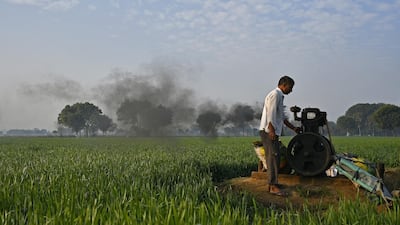India’s farmers are already feeling the effects of climate change, and agricultural output will suffer further as rainfall becomes more and more erratic, a government report has predicted.
The annual economic survey, published by India’s finance ministry on Monday, said changes in climate could shrink agricultural income by as much as 25 per cent in unirrigated farmland and 18 per cent in irrigated areas within the next 82 years.
But even these figures might underestimate the true impact of climate change, said the survey, which was overseen by prime minister Narendra Modi’s chief economic adviser, Arvind Subramanian.
"These are stark findings, given the already low levels of incomes in agriculture in India," it added.
___________
Read more:
Scientists warn climate change is leading to deaths on massive scale in India
Indian MPs trade blame over farmer’s suicide
___________
Farming was once the backbone of the Indian economy, contributing 52 per cent of India’s GDP in 1950.
Although that share has dropped steadily over the years, down to around 14 per cent today, a huge proportion of the population still depends on agriculture for its livelihood.
According to data from India's 2011 census, roughly 263 million Indians — around 22 per cent of the population — work in the sector, either as farmers or as agricultural labourers.
Among them is Aruna Urs, whose family has been farming land near the city of Mysore, in the state of Karnataka, for at least eight generations. In the summer, Mr Urs grows vegetables; after the monsoon has passed, in the final third of the year, he grows quinoa and chia.
Over the past decade, Mr Urs has been noticing spiking temperatures every April — the time when he would usually be starting to plant his tomatoes. "The peak temperature seems to have gone up by at least 2°C," he said. "Now 40°C has now become the norm."
As a consequence, the tomatoes suffer. Mr Urs now transplants his plants from the nursery to the field at night, when it’s cooler. Even so, half the plants die within a day. "The mortality rate [even five years ago] was just 10 or maybe 20 per cent."
___________
Read more:
Autumn still brings the choking smoke of burning crops to Delhi
Modi to survey flood devastation in Assam amid controversy
__________India
Summer temperatures are expected to rise further across the Indian subcontinent. If worldwide emissions do not decline, several parts of northern India will reach a fatal "wet-bulb" temperature of 35°C by the end of this century, according to research published by Massachusetts Institute of Technology scientists in August last year.
A so-called "wet-bulb" temperature factors humidity as well as heat into its calculations. At a wet-bulb temperature of 35°C, humans are unable to cool themselves through perspiration.
The shifting climate has also made rainfall over India more irregular. And in a country where roughly 52 per cent of the farmland is unirrigated — in other words, dependent on seasonal rain to water its crops — this is a big problem.
In times of heavy rain, crops are inundated or washed away; when rain is scarce, farmers resort to pumping more water out of the earth to water their crops, depleting groundwater resources as a result.
With this in mind, the economic survey said that India must irrigate more of its farmland.
"The challenge is that the spread of irrigation will have to occur against a backdrop of extreme groundwater depletion, especially in North India," the survey said. Irrigation relies, in part, on conserving and carefully distributing groundwater.
"India pumps more than twice as much groundwater as China or the United States," it added.
But many of India’s farmers are among the country's poorest people, unable to afford the installation of irrigation systems. The average farm household earns 6,426 rupees (Dh371) a month, according to government data.
"Labour is expensive. Machinery is expensive," said Jasjit Kang, an agronomist at Punjab Agricultural University. "Farmers just can’t afford these kinds of costly additions to their farms."
The unpredictable rainfall also brings another challenge: disease, wrought by bacteria, viruses and insects. Last year, for instance, unusually heavy spells of rain in Karnataka triggered an outbreak of armyworm, an insect that feeds on paddy, maize and millets. Nearly half a million acres of crops were destroyed, the state’s agriculture minister said in December last year.
"People near me grow millet, and I saw them spraying insecticide on their crops, because the infestation was so massive," Mr Urs said. "I’ve never seen people do that before. This was the first time they needed to do it."
As climate change further disturbs agricultural patterns, farmers will go into deeper distress. Since 1995, when the government started to keep relevant records, roughly 300,000 Indian farmers have committed suicide, unable to pay off their debts or improve their harvests.
A study published last year by a researcher at the University of California, Berkeley, found a correlation between farmer suicides and spikes in temperature in India.
"For temperatures above 20°C, a 1°C increase in a single day’s temperature causes [roughly] 70 suicides, on average," the researcher, Tamma Carleton, said, estimating that at least 59,000 suicides since 1980 can be attributed to a warming climate.
If agricultural families aren’t able to adapt to building temperatures, she added, “it’s likely we will see a rising number of lives lost to suicide as climate change worsens in India”.
But it won’t just be farmers who suffer, said Mr Urs.
“When plants suffer heat stress, they don’t yield. So the produce coming to the markets is much less, and the prices are much higher,” he said. “This is a bad thing for every single person who eats any food at all in India.”

